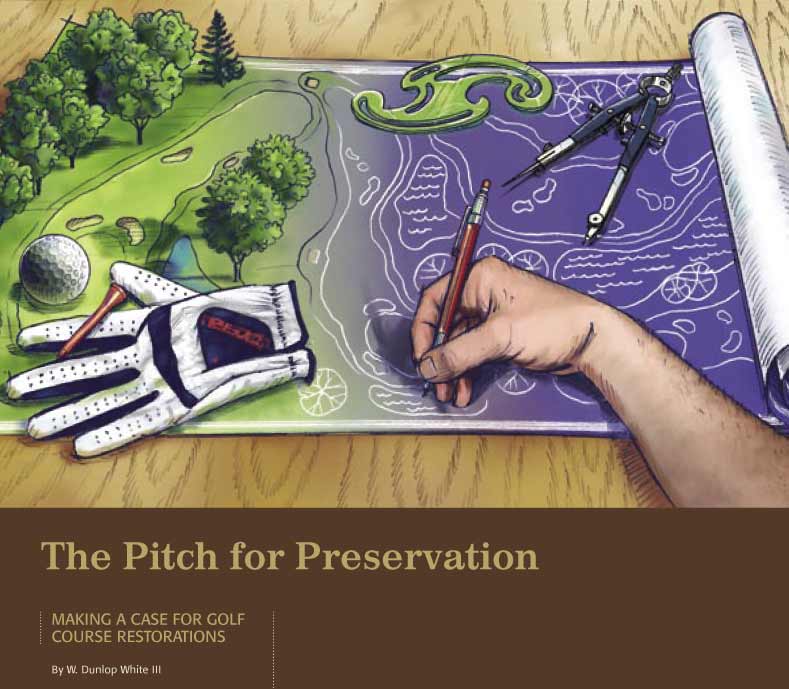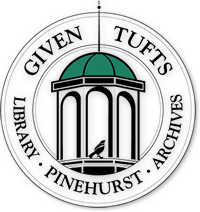Building a Case for Golf Course Restoration
By: W. Dunlop White III
Featured in "Carolinas Golf Magazine"

Walker Taylor IV operates a family-owned insurance agency in Wilmington (NC), but the toughest plan he's ever had to sell was a golf course restoration plan at Cape Fear Country Club. Taylor concedes that his biggest challenge was cultivating membership support for a restoration.
“It was mostly a timing issue with us”, says Taylor. “Some members didn't want to follow too closely behind other capital projects. Others didn't want to shut down our fairways for a year.”
In 2005, Taylor, who always fashioned Cape Fear as a historical artifact, helped convince his club to return their 1926 Donald Ross design to the approximate look, shape, and playing character of its original identity. Naturally, the club realized - a Ross design deserves close care and meticulous preservation.
Cape Fear is not alone. Time-honored clubs throughout the Carolinas are making the same pitch to their memberships on the virtues of classical golf course architecture.
Educating Your Membership
Because golf courses naturally evolve, memberships need to develop a better understanding of the detrimental impact that green committees and Mother Nature have had on their golf course. It's difficult to notice the damage in any one season, but over the course of 80 years, many classical golf courses have lost much of their original design character. Being able to visualize this transgression throughout time is a real eye-opener to the average club member.Historic aerial photographs can be quite revealing, especially when aligned in a chronological sequence for comparison. Better yet, Nolan Mills, a member of Charlotte Country Club's architectural committee, arranged a series of aerial overlays - with each page representing a decade. As Mills flipped through the decades, members immediately recognized that Ross' distinctive cross-bunkers had been abandoned over time, and his spacious fairways had been overrun with secondary tree plantings, hedgerows, and overgrown vegetation.
At Yeamans Hall outside of Charleston (SC), superintendent, Jim Yonce and former assistant pro, Jeffrey Fraim, collaborated to form a historical account of all man-made hole modifications dating back to famed architect, Seth Raynor. They color-highlighted and captioned every design feature, distinguishing those that were original from those that had been added or removed through the years. Other rare photographs yielded discoveries that their greens once possessed square corners with bold template patterns.
"Before and after" photography also serves as a convincing visual aid for memberships. Here, clubs can demonstrate how run-down, dilapidated bunkers can be cleaned of their excessive sand and spray build-up and expanded to their outer clay shells - recapturing original floor depths, shoulder contours, and their intended grass-line edges.
Finessing Club Politics
Because club members are always concerned with course conditioning, it would be smart politics to approach restoration plans with the emphasis on producing quality turfgrass. Rob Wilson, committee chair at the Country Club of Charleston (SC), admits that restoration is an attractive alternative when your fairways and greens suffer. “Reclaiming healthy playing surfaces was our primary motivation”, says Wilson. “Had we not had agronomic issues, a restoration wouldn't have even been on the table”.Club officials are also better off talking individually to important constituents of the membership, slowly developing a backing throughout the ranks. Architects, consultants, and other guest speakers are better positioned to give PowerPoint presentations before the entire membership. These third party experts are normally more persuasive, because memberships tend to trust those who don't have a personal interest or agenda in club politics.
Club officials, however, can struggle when addressing their entire membership in a "Town Hall" setting. Outnumbered and overwhelmed, they usually retreat into a defensive mode from the outset. In these situations, it is important to show a genuine respect for membership sentiment. Members tend to recoil when club officials make architectural pronouncements - however sound - that are delivered from a self-conferred perspective.
What's more, Kris Spence, a restoration specialist from Greensboro (NC), contends that memberships aren't normally interested in what other clubs are doing. Spence has found that memberships respond much better when you show a genuine respect for their particular golf course and their own design history.
Rival clubs are the possible exceptions. Whether clubs compete for prospective members or higher course rankings, “they usually want to know what their competition is up to”, says one observer. “It’s a matter of keeping pace in your market or keeping up with the Joneses next door.”
Promoting Your Architectural Heritage
Club officials also need to stimulate a greater sense of pride and appreciation for their architectural heritage. There are many tactics to put them in the proper frame of mind.Roaring Gap Club (NC), for example, armed clubrooms with original field drawings, green sketches, black-and-white photography, newspaper articles, and other Donald Ross memorabilia.
Should a debate ever arise over Ross’ intentions, members need only to consult their dining room wall, where a full-blown copy of the architect’s 1925 routing plan hangs.
Other clubs convert revealing aerial photographs into informal placemats for members to examine before meals. Still others reserve a historical page in their monthly bulletins for commentaries and perspectives of yesteryear.
Old Town Club in Winston-Salem (NC) commemorated their architect, Perry Maxwell, by commissioning a renowned artist to paint oil renderings of his noted golf holes throughout the country. Today, the member’s bar resembles a museum, boasting famous landscapes of Prairie Dunes, Crystal Downs, Augusta, and Pine Valley. The feature painting of Old Town's 12th green hangs over the fireplace across from a charcoal portrait of Perry Maxwell himself.

Marketing the Economic Value of Tradition
Club folks too often underestimate the value of tradition and heritage. Tradition is a time-acquired asset, which clubs should nurture and exploit. Certainly, a classical golf course is an attraction, but its authenticity makes it one of the most powerful marketing tools available for clubs today.Donald Ross, for instance, is a brand name of great reverence. The secret to his longevity is simple. Ross left behind an impressive legacy of 418 courses, where 100+ USGA national championships have been played. Today, twenty-five Ross thoroughbreds are ranked in Golfweek's "Top 100 Classical Courses", many of which gained their fanfare following a thoughtful restoration.
Golf course restorations also enable clubs to raise initiation fees and enjoy a full membership. Case in point: Carolina Golf Club in Charlotte (NC), which passed a four-phase restoration plan in April 2005. “Since that announcement, we’ve raised initiation fees from $9,000 to $16,000”, says club president, B.T. Atkinson. "We believe our restoration was a major contributing factor for all 112 members who have joined in the last eighteen months". Today, Carolina has reached their cap of 550 members and boasts a short waiting list, a telltale sign that the golf club is thriving.
“This phenomenon has been well documented at many other Ross venues around the country”, says Michael Fay, Executive Director of the Donald Ross Society. “Raleigh Country Club (NC) once faced an uncertain future but has prospered on the heels of a Ross restoration,” says Fay. Even today, Sedgefield Country Club in Greensboro (NC) has been able to attract 50+ new members just on the promise of new Ross beginnings.
But Fay cautions that there are numerous other examples where drastic modernizations have had the opposite impact. Membership levels often shrink and course rankings often plunge. This can only lead to the conclusion that tradition still has its dominance and relevance in the modern-day marketplace. It’s no small wonder that clubs throughout the Carolinas are buying into classical golf course restoration and fortifying the brand names of that genre.
Visiting Restorations and Playing the Classics
Ron Prichard, a restoration specialist and one of the pioneers of this discipline, believes that classical golf architecture best sells itself. Prichard, who will break ground at Charlotte Country Club this spring, claims that you can never fully explain to memberships the magic of these grand old classics no matter how hard you try.“You can speak of generous fairways, optional lines of play, meaningful bunkers, and undulating putting surfaces which are fearsome to putt and awe-inspiring to study. But classical architecture is more than the sum of these elements”, claims Prichard. “The magic must be experienced and felt first hand”.



